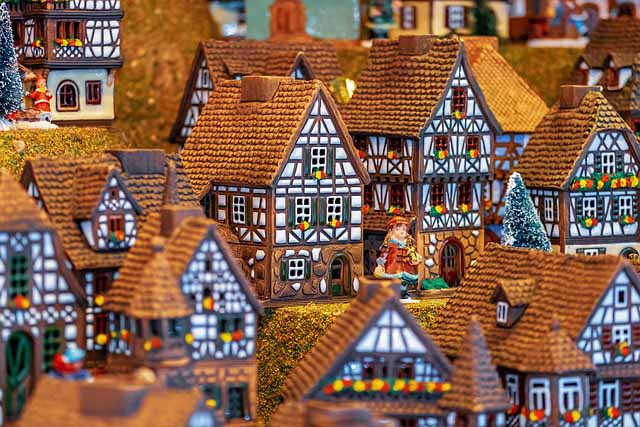Every child in any country in which Christmas is celebrated can’t wait until it’s Christmas Eve. Luckily little kids in Germany get a little foretaste on St. Nicholas Day (Nikolaustag in German or short Nikolaus), so they don’t have to wait that long.
Table of Contents
- Who was St. Nicholas?
- What is St. Nicholas called in German?
- How to say Happy St. Nicholas Day in German
- How did St. Nicholas become a Gift Bearer?
- Martin Luther railed against St. Nicholas Day
- Knecht Ruprecht – St Nicholas sinister Companion
- What does St. Nicholas look like?
- What does Coca-Cola have to do with our idea of Santa Claus?
- How do Germans celebrate St. Nicholas day?
Who was St. Nicholas?
In the figure of St. Nicholas two historical persons are merged into one. One is Nicholas of Myra, bishop of Myra, a city in present-day Turkey. He lived in the third century. On the other hand, Nicholas of Sion, a place near Myra, from the sixth century. The legends about the lives of the two men interwove to form the mythical figure of Saint Nicholas of Myra. He is said to have performed numerous miracles, including, for example, calming a storm and bringing several dead people back to life. One story tells of him helping an impoverished father of three daughters: the desperate father can’t ay a dowry for his daughters and is on the verge of sending them into prostitution. St. Nicholas helps them by secretly throwing gold coins through the window of the three virgins at night. The myth of the merciful helper and protector, who gives gifts to children unrecognized in the night, is born.

What is St. Nicholas called in German?
He is called St. Nikolaus or simply Nikolaus. He is the patron saint of sailors and merchants and therefore was very popular during the reign of the German Hanseatic League (die Hanse in German). Every German city that used to be a member of the Hanseatic League has a Nikolai church to honor the patron saint.
How to say Happy St. Nicholas Day in German
When Germans want to wish each other a happy St. Nicholas day, they usually use one of these phrases:
- Fröhlichen Nikolaustag!
- Frohen Nikolaustag!
- Alles Gute zum Nikolaustag!
How did St. Nicholas become a Gift Bearer?
Beginning in the 12th century, people celebrated the Feast of St. Nicholas on December 6th, giving each other small presents.
Martin Luther railed against St. Nicholas Day
But during the Reformation, Martin Luther railed against the cult of the saint and condemned St. Nicholas gift-giving as a “childish thing.” He tried to replace the old custom with Christmas gift-giving. But people hold on to the cherished custom, not only in the catholic regions of Germany.
Knecht Ruprecht – St Nicholas sinister Companion
However, from the 19th century at the latest, St. Nicholas is not only a kind bearer of gifts and treats, but also a punisher of naughty children. He is often accompanied in precisely this role by a more sinister figure who is supposed to scare bad children and has a different name depending on the region: Knecht Ruprecht, Pulterklas or even Krampus. Instead of a big sack of presents, he usually carries a rod. But he did not always play the role of evil in history: In the 19th century, it was assumed that St. Nicholas’ helper could be traced back to pagan rituals: in winter, he was on the road to drive away evil spirits.
Other theories, however, paint him in a much darker light: for example, Knecht Ruprecht is said to have been a priest who cursed exuberantly celebrating Christmas and dancing children in 1021. Others point to an origin in the later Middle Ages, when the child terror was used to support educational measures. In any case, however, he is seen as an antagonist to St. Nicholas.
What does St. Nicholas look like?
In catholic southern Germany, Saint Nicholas is usually still seen in the traditional robe with a bishop’s staff and miter, the high bishop’s miter. In the north, on the other hand, the idea of St. Nicholas as a jovial old man with a long white beard and a thick red coat has prevailed – and thus comes close to that of Santa Claus.
And that is no coincidence, as traditionally St. Nicholas day used to be the feast day when parents would give their children little gifts and treats like nuts, apples or sweets. It was due to Martin Luther’s rejection of the worship of St. Nicholas which finally made Christmas a holiday on which children were given presents. So Father Christmas and St. Nicholas have the same roots.

What does Coca-Cola have to do with our idea of Santa Claus?
Until the 19th century, Santa Claus was often depicted in blue or white robes. It is often said that Coca-Cola invented the red American Santa Claus to match its own red logo. However, this is not entirely true. The red coat was actually developed by the German emigrant Thomas Nast. As early as 1862, he drew Santa Claus in the USA with a white beard, red coat and fur-trimmed cap. It was not until 1931 that Coca-Cola used the figure of Santa Claus in an advertising campaign.

How do Germans celebrate St. Nicholas day?
For generations, the custom of St. Nicholas’ boots has existed in Germany on St. Nicholas’ Day. On the eve of December 6th, children clean their boots or shoes and put them outside the door. Overnight, St. Nicholas arrives, (usually represented by the parents,) and fills the boots with sweets and small gifts. In earlier times, instead of boots, handmade paper boats were placed in front of the door. “Ship setting” was the name of this custom.
Particularly impressive for little children is a personal visit from St. Nicholas, who usually comes equipped with a big sack and a golden book and presents a small gift in their home.
In some parts of Germany, children dress up as Santa Clauses on the evening of December 6, go from house to house and ask for sweets.
Other traditional customs include reading a nice St. Nicholas story together or singing St. Nicholas carols. Religious families may also visit a church service.




